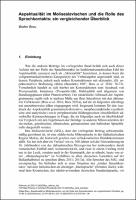Chapter Aspektualität im Moliseslavischen und die Rolle des Sprachkontakts: ein vergleichender Überblick
| dc.contributor.author | Breu, Walter | |
| dc.date.accessioned | 2023-11-27T17:12:48Z | |
| dc.date.available | 2023-11-27T17:12:48Z | |
| dc.date.issued | 2023 | |
| dc.identifier | ONIX_20231127_9791221501841_19 | |
| dc.identifier.issn | 2612-7679 | |
| dc.identifier.uri | https://library.oapen.org/handle/20.500.12657/85609 | |
| dc.language | German | |
| dc.relation.ispartofseries | Biblioteca di Studi Slavistici | |
| dc.subject.other | Molise Slavic | |
| dc.subject.other | aspect | |
| dc.subject.other | language contact | |
| dc.subject.other | modality | |
| dc.subject.other | phasal verbs | |
| dc.subject.other | imminentive | |
| dc.subject.other | passive | |
| dc.subject.other | progressive | |
| dc.subject.other | perfect | |
| dc.subject.other | triangulation | |
| dc.title | Chapter Aspektualität im Moliseslavischen und die Rolle des Sprachkontakts: ein vergleichender Überblick | |
| dc.type | chapter | |
| oapen.abstract.otherlanguage | This paper has two main objectives, to present some essential aspectual properties of Molise Slavic in comparison with other varieties in situations of strong language contact, and to discuss the role of language contact in each of these. Besides the grammatical categories of verbal aspect in the narrow sense, we deal with several more or less grammaticalised periphrases that also express aspectual functions or whose usage, at least, is triggered under the influence of verbal aspect. As in some other Slavic languages, having preserved traces of the original dual aspect system, Molise Slavic still displays a morphosyntactic aspectual opposition expressed by means of the perfect vs. imperfect, in addition to the Slavic derivational opposition between perfective vs. imperfective. Both oppositions combine with each other. The role of Romance in the reorganisation of these categories is discussed. The most salient innovation from a formal perspective is the imminentive calqued from Italian, but combinations of full verbs with phasal and modal verbs also show Romance influence. The results of the influence of dominant varieties on Molise Slavic in the area of aspectuality are compared with the development and behaviour of corresponding phenomena in the other languages and language families presented in this volume, in particular Resian and Slavic minority languages in Austria and Germany, Italo-Albanian, Italo-Greek, Baltic, German-based varieties in Northern Italy and Macedonian-based varieties in Albania and North Macedonia. | |
| oapen.identifier.doi | 10.36253/979-12-215-0184-1.06 | |
| oapen.relation.isPublishedBy | bf65d21a-78e5-4ba2-983a-dbfa90962870 | |
| oapen.relation.isbn | 9791221501841 | |
| oapen.series.number | 53 | |
| oapen.pages | 52 | |
| oapen.place.publication | Florence |

